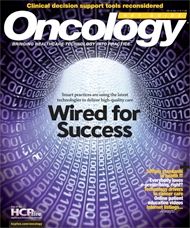Tech Talk: Point-of-Care Information
Remember in the 1960s Star Trek series when Dr. McCoy would pass his medical tricorder over a prostrate body to discover not only which species of alien had invaded the young ensign, but also how to expel the creature with a dose of medicine?
Remember in the 1960s Star Trek series when Dr. McCoy would pass his medical tricorder over a prostrate body to discover not only which species of alien had invaded the young ensign, but also how to expel the creature with a dose of medicine? McCoy’s tricorder combined both a universal diagnostic device and a medical information database of boundless proportions. Who could want anything more?
That futuristic vision of point-of-care information technology is still a long way off, but the concept was a remarkably accurate prediction of where we are heading today. “Point-of-care” is an amorphous concept that changes depending on your point of view. For small medical practices, point-of-care generally means providing evidence-based medical advice to physicians as they are diagnosing and developing their plan of action. Information sources range from reference materials to patient records to drug reference tools and so on.
Until the 1990s, many primary care practices relied on textbooks, and later, referenceable CD-ROMs. But as we were forced to see more patients in a shorter amount of time to make ends meet, we moved to more concise, pocket-sized guides that summarized the important facts. Those guides are now being supplanted by applications and databases that run on tablets, handhelds (like PDAs and PalmTreos), and increasingly on smartphones (like the BlackBerry, iPhone, and the new G1 running on Google’s open mobile phone platform called Android).
There are three different models for point-of-care information delivery: static, push, and pull. With one of the most popular mobile point-of-care applications ever, Epocrates Rx—a free drug and formulary reference—users download a fixed database that resides on their device. The database is not updated until the user downloads a new version. On the other hand, 5-Minute Clinical Consult (5MCC) Online provides instant access to the essentials of 700+ medical conditions. Users “pull” information, including dermatology images, videos of medical procedures, AAFP patient handouts, and more. By contrast, Skyscape’s MedAlert “pushes” up-to-the-minute clinical information, such as drug updates, journal summaries, and clinical trial results by specialty, to a cell phone, smartphone, PDA, or desktop.
With the addition of wireless networking technology, healthcare providers can get real-time, point-of-care information on differential diagnosis, testing, and treatment options as they see the patient and come up with the plan. The power to hop onto Google and search for any subject puts a virtually unlimited source of information right at our fingertips, although sorting through the data to differentiate the wheat from the chaff remains the most difficult aspect of such a plethora of information.
Of course, short of simply knowing the information from our extensive training and continuing medical education, the most logical way to be presented with this medical data is through our electronic health record during the patient encounter. This is the actual point-of-care, and having evidence-based information pop up in one’s EHR at that moment would be remarkable.
The EHR could intelligently and proactively retrieve pertinent information as demographics, symptoms, vital signs, and other relevant data is entered into the patient’s chart. This data could be analyzed behind the scenes, patterns could be recognized, and recommendations presented to the physician.
As we gaze ever further into the future, perhaps to when intergalactic space travel or beaming ourselves from room-to-room is actually possible, physicians may someday have chips containing all of the known information about health and the medical sciences embedded into their brains. Until that time arrives—may you live long and prosper.
What point-of-care references and diagnostic aids do you use? Are you satisfi ed with the products currently on the market?
Dr. Bertman is Physician Editor-in-Chief of MDNG: Primary Care/Cardiology Edition. He is a Clinical Assistant Professor of Family Medicine at Brown University and president of AmazingCharts.com, a leading developer of EHR software. He is also the founder and president of AfraidToAsk.com, a consumer website focusing on personal medical topics. He is in private practice in Hope Valley, RI.
